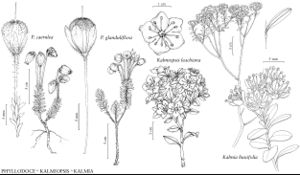Difference between revisions of "Kalmiopsis"
J. Arnold Arbor. 13: 31, plate 40. 1932 ,.
FNA>Volume Importer |
FNA>Volume Importer |
||
| Line 21: | Line 21: | ||
|distribution=sw Oreg. | |distribution=sw Oreg. | ||
|discussion=<p>Species 2 (2 in the flora).</p><!-- | |discussion=<p>Species 2 (2 in the flora).</p><!-- | ||
| − | --><p>Kalmiopsis is the only vascular plant genus endemic to the state of Oregon; it is cultivated for its showy flowers. Although early tradesmen found Kalmiopsis a difficult subject for propagation, plants can be grown with perseverance and are today occasionally established in private and public gardens in the Pacific Northwest, Europe, and elsewhere. The plants are evidently long-lived and generally reproduce infrequently in nature. Flowers exhibit a pronounced stigma height polymorphism; further study is needed to assess its breeding system significance. Distyly is otherwise unknown in the Ericaceae, with the possible exception of Epigaea repens, a dioecious species that exhibits a continuum of long- and short-styled flowers yet lacks other evidence of heterostyly. The genus is the namesake for the Kalmiopsis Wilderness Area, a remote region just east of the Pacific Ocean that is rich in endemic species and remarkable substrates.</p> | + | --><p><i>Kalmiopsis</i> is the only vascular plant genus endemic to the state of Oregon; it is cultivated for its showy flowers. Although early tradesmen found <i>Kalmiopsis</i> a difficult subject for propagation, plants can be grown with perseverance and are today occasionally established in private and public gardens in the Pacific Northwest, Europe, and elsewhere. The plants are evidently long-lived and generally reproduce infrequently in nature. Flowers exhibit a pronounced stigma height polymorphism; further study is needed to assess its breeding system significance. Distyly is otherwise unknown in the <i>Ericaceae</i>, with the possible exception of <i>Epigaea repens</i>, a dioecious species that exhibits a continuum of long- and short-styled flowers yet lacks other evidence of heterostyly. The genus is the namesake for the <i>Kalmiopsis</i> Wilderness Area, a remote region just east of the Pacific Ocean that is rich in endemic species and remarkable substrates.</p> |
|tables= | |tables= | ||
|references= | |references= | ||
| Line 56: | Line 56: | ||
|publication year= | |publication year= | ||
|special status= | |special status= | ||
| − | |source xml=https://jpend@bitbucket.org/aafc-mbb/fna-data-curation.git/src/ | + | |source xml=https://jpend@bitbucket.org/aafc-mbb/fna-data-curation.git/src/8f726806613d60c220dc4493de13607dd3150896/coarse_grained_fna_xml/V8/V8_935.xml |
|subfamily=Ericaceae subfam. Ericoideae | |subfamily=Ericaceae subfam. Ericoideae | ||
|genus=Kalmiopsis | |genus=Kalmiopsis | ||
Revision as of 19:09, 18 September 2019
Shrubs, (sometimes rooting adventitiously and suckering). Stems erect or trailing, (branching from base); twigs (terete), puberulent and sparsely sessile- or stipitate-glandular, becoming glabrate, (older twigs without peglike projections). Leaves persistent, alternate; petiole present; blade coriaceous, margins entire; (buds with sessile glands). Inflorescences terminal, corymbiform racemes, 2–15-flowered; perulae absent. Flowers bisexual, radially symmetric; sepals (persistent), 5, nearly distinct; petals 5, connate ca. 1/3–1/2 their lengths, corolla deciduous, campanulate; stamens 10, exserted; anthers not awned, dehiscent by apical pores; ovary 5-locular, (subglobose); stigma capitate. Fruits capsular, (5-valved), subglobose, dehiscence basipetally septicidal. Seeds ca. 50–150, ovoid, not winged, not tailed; testa reticulate. x = 12.
Discussion
Species 2 (2 in the flora).
Kalmiopsis is the only vascular plant genus endemic to the state of Oregon; it is cultivated for its showy flowers. Although early tradesmen found Kalmiopsis a difficult subject for propagation, plants can be grown with perseverance and are today occasionally established in private and public gardens in the Pacific Northwest, Europe, and elsewhere. The plants are evidently long-lived and generally reproduce infrequently in nature. Flowers exhibit a pronounced stigma height polymorphism; further study is needed to assess its breeding system significance. Distyly is otherwise unknown in the Ericaceae, with the possible exception of Epigaea repens, a dioecious species that exhibits a continuum of long- and short-styled flowers yet lacks other evidence of heterostyly. The genus is the namesake for the Kalmiopsis Wilderness Area, a remote region just east of the Pacific Ocean that is rich in endemic species and remarkable substrates.
Selected References
None.
Lower Taxa
Key
| 1 | Tufted, erect shrubs, 2-4(-8) dm; petals connate ca. 1/2 their lengths; filaments 3-7(-10) mm; corolla throat puberulent, inner surface of connate portion puberulent to glabrous; endemic to Siskiyou Mountains. | Kalmiopsis leachiana |
| 1 | Loose, erect to trailing shrubs, usually to 12(-30) dm; petals connate ca. 1/3 their lengths; filaments 7-16 mm; corolla throat mostly glabrous, inner surface of connate portion with basal tufts of yellowish cilia; endemic to s Cascade Mountains. | Kalmiopsis fragrans |
